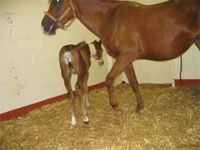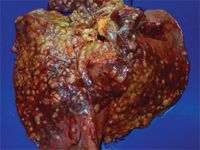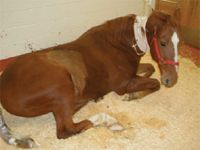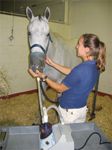Selected topics in rational antimicrobial usage (Proceedings)
Dr. Alexander Fleming (1928) initiated the 'modern age of medicine' with the discovery of penicillin.
Dr. Alexander Fleming (1928) initiated the 'modern age of medicine' with the discovery of penicillin.
Drs. Fleming, Florey & Chain (1945) were awarded the Nobel Prize in medicine. They received no money for their amazing discovery.
The Four Basic Human Drives
1. To seek food and shelter
2. To seek care and nurture
3. To procreate
4. To administer antibiotics to everything that moves
Beta-lactam antibiotics
- Penicillin- Procaine penicillin G, Na or K penicillin
- Synthetic penicillins- ampicillin, amoxicillin, ticarcillin
- Cephalosporins-
- First generation- cefazolin, cephalexin
-Third generation- ceftiofur, ceftazidime
- Fourth generation- cefepime
o all have extended gm (-) activity
o increased resistance to B-lactamase org.
- Most infections in horses caused by B-hemolytic strep. (uniformly susceptible to penicillins).
Beta-lactam antibiotics
- Primary cephalosporin administered to horses is ceftiofur.
- Advantages include broad spectrum of activity and good safety profile.
- Several studies have evaluated concentrations (lungs, plasma) and safety of ceftiofur over wide range (1.1mg/kg to 11mg/kg) IM and IV.

Ceftiofur
- Approved for use in horses for respiratory tract infections(2.2 to 4.4 mg/kg Q24 IM).
- Higher doses recommended for treating gm (-) (Klebsiella, Salmonella, Enterobacter).
- Important to maintain concentrations above MIC with gm (-) (No post-antibiotic effect).
- Unlike other cephlosporins- it is extensively metabolised (desfuroylcetiofur DFC)- primarily excreted in urine
- In calves w/ tissue chamber infection model; ceftiofur & DFC higher conc in infected chamber
- Protein bound DFC is reservoir for active drug at site of infection (reduced dosing interval)
- Protein binding extends effective t ½
- PK profile; IV vs. IM vs. SQ
- 99% protein bound (clinically significant)
- Binds to acute phase proteins (a1-anti-trypsin) which carries bound drug to sites of inflammation
- Time dependent antimicrobial
- Label dose is 2.2 to 4.4 mg/kg q 24h IM.
- Higher doses (5-10 mg/kg) q 12h IV or IM clinically successful in treating septicemic neonates.
- The IM route of administration + lack of "penicillin rxn's" + broad spectrum of activity = excellent utility in treating polymicrobic infections (pleuropneumonia)
Oral B-lactams?
- Very poor absorption and bioavailability
- 2 recent studies in foals; cephalexin and cephadroxil dosed at 30mg/kg PO q 12 hrs was effective
Trimethoprim-Sulfonamide
- Considered -cidal at high concentrations.
- Lipophylic and penetrates tissues well (CNS).
- Broad-spectrum coverage (gm (+), (-) and some anaerobes.
- Interfere with synthesis of folic acid from PABA with sulfonamides competitively inhibiting PABA.
- Purulent fluids rich in protein and PABA, this will decrease TMS activity.
- Good activity against many Strep organisms- although some resistance noted despite susceptibility results.
- Potentiated sulfas Not recommended for initial treatment of S.equi infections; Verheyen K, Newton J et al. Elimination of guttural pouch infection and inflammation in asymptomatic carriers of Streptococcus equi. Equine Vet J. 2000; 32. 527-532.
- Excellent GI absorption although reduced substantially by feeding....(delay feeding).
- Lack of clinical activity against anaerobes.

Potentiated Sulfas
- t½ =sulfamethoxazole 3.5-5 hrs.
- t½ =sulfadiazine 3-4 hrs.
- t½ =trimethoprim 2-3 hrs.
- BID PO dosing is necessary to attain therapeutic plasma concentrations of trimethoprim (Dowling in Bertone,2004)
Trimethoprim-Sulfonamide
- Oral formulation containing TMP with sulfadiazine in a 1:5 ratio commonly dosed at 20 to 30mg/kg BID.
- In horses- rapid elimination of TMP leads to >persistence of sulfonamide and changes optimal ratio. Therefore, potentiated sulfonamides should be dosed BID.
Erythromycin
- Macrolide; bacteriostatic except at high dosages they are -cidal.; good tissue distribution.
- Good activity Strep. Staph. Bacteroides, & Rhodococcus.
- Poor activity E.coli, Pseudomonas, Klebsiella & Salmonella.
- R. equi pneumonia- 25mg/kg q 6-8 hrs will achieve plasma conc. which exceed MIC.
Azithromycin
- Pharmacokinetic advance in macrolide arena.
- High oral bioavailability, large Vd (18.6L/kg) and peritoneal = synovial = serum conc., T½ = 20hrs, conc. in bronchoalveolar cells 15- 170x [serum].
- Impression; fewer GI issues.
- Dose;10 mg/kg QD for 5 days then q 48hrs per os.
- Significant advantage over erythromycin.
- Cost +/- $50/day
- Bioavailability =56% in 6 healthy foals
- BAL concentrations 15-170X serum
- PELF concentrations 1-16X serum
- 10mg/kg QD PO for 5 days then reduced to every other day (suggested)
- (Jacks, 2001)

Newer Macrolides
- Broader spectrum than erythromycin.
- Clarithromycin- more effective than azithromycin against R.equi in vitro. Improved efficacy in severe R.equi pneumonia as compared to erythro or azithromycin. (Giguere ACVIM 2003)
- Dosage= 7.5mg/kg BID + rifampin (higher incidence of diarrhea?)
Clarithromycin
- Oral bioavailability =57.3% +/- 12.0%
- 7.5 mg/kg BID PO provides serum, pulmonary epithelial lining and bronchalveolar cells of foals above MIC for R. equi isolates during entire 12 hr period
- Determined in 6 healthy foals
- (Womble, 2006)
Tulathromycin
- New injectable macrolide for tx of pulmonary dz in cattle and swine
- Lung concentrations above MIC90 for 15 days for P.multocida
- Study in foals; 2.5mg/kg IM Q 7 days (#37 foals with lung abscesses)
- Results; tulathromycin well tolerated for tx of pulmonary abscesses in foals
- *NB- very pH sensitive- strong distribution in lung tissue- inactive in acidic environments
Rifampin
- Bioavailability is 40 – 70%, lower bioavailability if fed with feed
- t½ =17 hrs. in foals, 6-8 hrs. in adults
- Dose 5mg/kg BID PO
- Emerging resistance especially if used as a monotherapy (Takai, 1997)
Tetracycline
- Broad-spectrum bacteriostatic activity.
- Excellent tissue penetration (including CNS).
- High GI conc. which may cause diarrhea.
- Effective against rickettisial organisms (N.risticii) oxytetracycline; 5-10mg/kg q 12-24 hrs iv
Doxycycline
- Semi-synthetic tetracycline.
- Good bioavailability, t½ = 10-12 hrs.
- CNS penetration and good gm(+) activity.
- Dose; 10 mg/kg BID per os
Chloramphenicol
- Bacteriostatic (-cidal at high conc.)
- Broad spectrum activity; gm(-), (+) & anaerobes.
- Good intracellular penetration.
- Rapidly metabolized by the liver (short t½).
- Oral administration (very bitter).
- Minimize human exposure (animal toxicity rare).
- Dosage 25- 50 mg/kg q 4 to 6 hrs per os
Fluoroquinolones
- Very active against enteric gm(-) and many aerobic gm(+). No anaerobic activity.
- Enrofloxacin- good bioavailability and tissue penetration (higher conc. in resp. tract than serum).
- Arthropathies are concern in foals-not substantiated in adult horses.
- Injectable- 2.5 to 5mg/kg QD, oral- 7.5 to 10mg/kg QD is recommended. Good PAE.
Aminoglycosides
- Widely used for treatment of gm(-) infections.
- Purulent debris will bind AB and decrease activity.
- Physiologic and disease considerations;
- endotoxemia, dehydration, colitis physical immaturity (neonates) will increase risk of nephrotoxicity.
- Once daily dosage for gentamicin (7mg/kg) and amikacin (21mg/kg) routinely used.
Amikacin
- Concentration dependent aminoglycoside
- Once daily dosing is safer than more frequent administration while being as effective
- Dose 10mg/kg in horses
- Dose 25mg/kg in foals (Papich, 2005)
Aminoglycosides
- If a q24 h approach to dosing is employed, it should be augmented with another AB with gm(+) activity (ampicillin, ceftiofur).
- Serum aminoglycoside assays available at human & vet hospitals.
- Due to individual variability & alterations from dz states, therapeutic monit. should be employed to optimize dose & interval.
Metronidazole
- Nitroimidazole anti-infective- selectively taken up by anaerobes
- Effective vs. anaerobic (Clostridium spp) bacteria and protozoa (Giardia and Trichomonas spp.)
- Vd= 1-2 l/kg
- t½= 3-4 hrs.
- Concentration dependent antimicrobial
- Dose 15-20 mg/kg TID PO
- Widely used for colitis
- Resistance reported (rare) for C.difficile isolates
- Less information available for C.perfringens
- Neonates- 10mg/kg PO q 8-12 hours
- PK profile- Per Os > IV
- Pleuropneumonia PK; 15mg/kg initially followed by 7.5mg/kg PO q6h
Polymyxin B
- Cationic detergent AB (gram -) binds to cell membrane making it more permeable
- PMB was found to decrease in vivo endotoxin-induced TNF activity
- Compared with baseline values 5,000 U of PBM/kg should inhibit 75% of endotoxin induced TNF activity for 12 hours (Parviainen, 2001)
Antimicrobial Synergy
- Enhanced activity when two or more drugs administered concurrently.
- Aminoglycosides demonstrate synergy when used with beta-lactams- due to enhanced aminoglycoside bacterial penetration resulting from degradation of cell wall ?
- Other combinations with synergy include:
Macrolide + fluoroquinolone cephalosporin + fluoroq.

Rifampin + beta-lactam chloramphenicol + beta-lact.
Antimicrobial Induced Colitis?

C. difficile: prevalence in horses...
- Objective: Survey C. difficile colonization in GI tract with age, occurrence of diarrhea & history of AB therapy.
- Methods: evaluated 777 horses (including 277 foals) of different breeds, age and sex. AB susceptibility was investigated.
- Results:
- In horses that developed acute colitis during AB treatment- 18 of 43 were + to C. difficile.
- C. difficile was isolated from 4 of 72 horses with diarrhea and no AB treatment.
- In NORMAL healthy foals < 14 days of age, C.difficile was isolated in 16 of 56 foals.
-In foals without diarrhea and treated with erythromycin, gentamicin +/- rifampicin, 7 of 16 foals were (+) for C.difficile.
-C.difficile survived in nature and indoors for at least 4 years.
-Antibiotics evaluated (in horses & foals with colitis) included; penicillin, ampicillin, gentamicin, tetracycline and TMP/SDZ.
- Susceptibility testing of 52 strains for 10 antibiotics- metronidazole (MIC <4mg/l) & vancomycin (MIC <2mg/l).
- Conclusions:
- C. difficile is associated with acute colitis in mature horses following antibiotic tx. Additionally, it was isolated from 1 in 3 normal healthy foals <14 days.
Additional Applications?

Future Shock
- FDA recently prohibited the use of enrofloxacin for bacterial infections in poultry.
- Observed resistance in Campylobacter jejuni when used to treat respiratory infections.
- Fluoroquinolone drugs do not clear organism from GI tract and resistant organism quickly spreads...
- Are We Next??
Godzillacillin !!
- Does 'cutting edge' medicine mean finding uses for the hot new drug in human medicine?
- The empirical use of enrofloxacin or vancomycin in horses is a MAJOR concern.
- Can we be effective stewards of public health and avoid regulatory action by FDA?